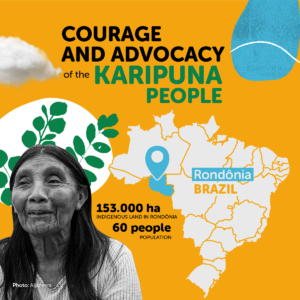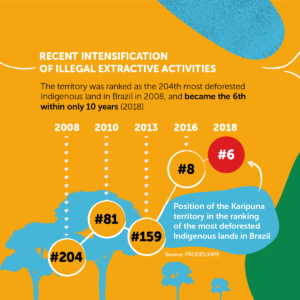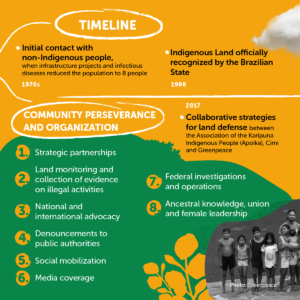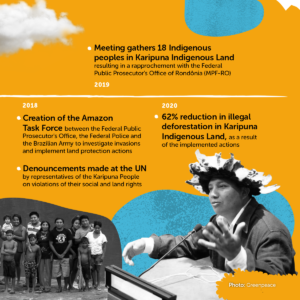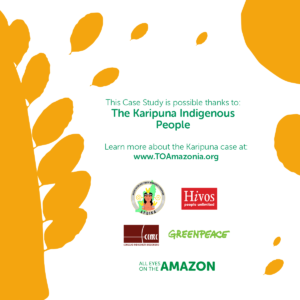Paths of Resistence – Case Studies Series
This case study presents how the Karipuna Indigenous People of Rondonia, which inhabits Rondonia State in the Brazilian Amazon, promoted, with the support of partnerships, strategies for territorial monitoring, advocacy campaigns, and legal complaints about deforestation and invasions in their territory, resulting in a reduction of 62% in deforestation rate, being presented prominently in the integrated training program in the analysis of complex and transnational environmental crimes, carried out through the Environment Commission (CMA) of the National Council of Prosecution Services (CNMP), in partnership with the National Strategy for Justice and Public Security (ENASP), the National Council of Justice (CNJ) and the Brazilian Association of Members of the Environment Prosecution Office (ABRAMPA).
1. Case Study Video
2. The Case Study in a Nutshell
3.1. Context and Challenges
Key Information
Indigenous people: Karipuna
Location: State of Rondônia, in the Southwest of the Brazilian Amazon, in the border region with Bolivia
Area: 153,000 hectares
Population: Approximately 60 people
Main activities: Fishing and nuts’ extraction
Local AEA partners involved: Conselho Indigenista Missionário (Cimi)
- The Karipuna Indigenous Land is located between the cities of Porto Velho and Nova Mamoré, in the State of Rondonia, in a 153,000-hectare area that was homologated by the Brazilian government in 1998. The territory is situated at the border between Brazil and Bolivia and is part of the Brazilian Legal Amazon.
- Currently, there are about 60 Karipuna Indigenous people, while 22 of them live in the Panorama village within the territory. Contact was made with the Karipuna people in 1976, when their population was reduced to 8 individuals due to the implementation of infrastructure projects that decimated local populations through conflicts and contagious diseases.
- Presently, according to the Forest Burning Program of the National Institute for Space Research (INPE), Karipuna is the Indigenous Land most threatened in Brazil by fires registered in the surrounding area (an area of 5 km from the border). The hot spots in the surrounding area derive from pasture areas around the Indigenous Land; thus, the renewal process of these areas includes burning of the vegetation, which results in fires that are a serious threat to the biodiversity and population of the territory.
- In 2020, the Karipuna Indigenous Land was the 9th most deforested in Brazil and the most deforested indigenous territory in the state of Rondonia, with 1,082 ha of forest loss registered between 2020 and 2019. Until 2014, there was hardly any deforestation in the territory. However, in these last six years, 5,126.29 ha have been deforested. According to the Amazon Deforestation Calculation Program (PRODES), in 2019 alone, 1,122.04 ha were deforested in the Karipuna land.
- The fires and deforestation arise from four interrelated factors: invaders, loggers, land grabbers, and the existence of grazing areas and fire spots around the territory. In addition, the violations are made worse by threats: in 2018, according to the Indigenist Missionary Council (CIMI), two threats to indigenous leaders of the Karipuna land were registered (data from the report on violence against indigenous peoples).
- Deforestation and land grabbing became more intense as of 2016, the same year of the construction of the Indigenous Surveillance Post (PIV) of the Brazilian Indigenous Foundation (FUNAI), located inside Karipuna territory – financed by company Santo Antônio Energia, as counterpayment for the construction of the Santo Antônio hydroelectric plant. There have been several attacks on the building since 2017, and in 2018, the PIV was destroyed by an arson fire, an action that has become a symbol of the onslaught of illegal loggers and land grabbers on the site. According to Karipuna representatives, the invaders began to use the Funai Post as a shelter and base to expand their illegal activities inside the territory.
- Government enterprises to build the Santo Antônio and Jirau hydropower plants, inaugurated in 2016, were supported by the World Bank and have generated impacts on the territory, such as flooding.

- In this regard, since 2017, representatives of the Karipuna people, with the support from partners, have made several complaints to the competent authorities and the international community. Since 2018, such complaints have led to federal operations that have culminated in the identification of criminal organizations and the arrest of those responsible.
3.2. Strategy: key-factors to overcome the challenges
- Strategic partnerships: As the Karipuna population is small, with few people, the territorial defense strategies are concentrated on territorial monitoring made directly in the field by the Karipuna and CIMI, avoiding contact and confrontation with invaders. Thus, the main strategies to defend the rights and territory of the Karipuna are: gathering evidence of illegal activities carried out in the Karipuna territory; complaints to the competent authorities; political advocacy and social mobilization through national and international advocacy campaigns. For all these actions, the Karipuna people rely on strategic partnerships made through the Indigenous Association of the Karipuna Abytucu Apoika (Apoika). In this sense, partnerships with the CIMI and Greenpeace stand out, within the scope of the All Eyes on the Amazon program.
- Collection of evidence via territorial monitoring: For many years, the Karipuna people have been promoting actions for patrolling, monitoring and mapping their territory to identify georeferenced coordinates of the sites of invasions or illegal extractive activities. It is important to stress the magnitude of the difficulty in patrolling a territory of 153,000 hectares with a population of only 60 people. There are various challenges ranging from the logistics of moving around, requiring different means of transportation such as boats, horses, planes, and even on foot, to security issues such as animal attacks and potential confrontation with invaders. Also for these reasons, the Karipuna people have the support of strategic partners for territorial monitoring actions. In June 2018, Greenpeace, CIMI, and a Karipuna leadership flew over the Karipuna territory to identify fire spots and the extension of deforestation. From this action, they were able to identify the illegal construction of roads to access the territory, besides detecting large areas of forest that targeted for timber extraction and clearings with a great amount of logs that would be transported. In February and July 2019, additional overflights were made, which identified the opening of clandestine roads for the flow of illegally harvested wood, as well as small facilities near vicinal roads. Overflight monitoring of the territory is complemented by primary data collection through satellite systems, such as Sentinel B, Panchromatic and PLANET (all from Landsat / Engesat), which in turn are complemented by data made available by the projects Real-Time Deforestation Detection (DETER – INPE) and Deforestation Alert System (SAD – Imazon). As a result of such monitoring, Greenpeace’s geoprocessing analysts found that at least 7,640 ha of forest were degraded in the territory between 2015 and 2018. It is worth highlighting that of the 10,463 ha of degraded and cleared forests within the Karipuna land from 1988 to 2018, over 80% occurred between 2015 and 2018 – that is, there has been a marked escalation of illegal extractive activities in the Karipuna territory in recent years. However, this scenario is starting to be reversed as a result of the monitoring, reporting, political advocacy, and awareness campaigns. Between August 2019 and July 2020, there was a 49% reduction in the illegal clearing of native vegetation compared to the same period last year, standing at 580 hectares. In comparison to the figures recorded between August 2017 and July 2018, this deforestation reduction accounts for 62%.

- International advocacy: A major axis of action has been the promotion, through partnerships, of communication actions and national and international advocacy to raise the awareness of authorities and public opinion about the violations that take place in the Karipuna territory. For example, in April 2018, Adriano Karipuna leadership attended the 17th Session of the United Nations Permanent Forum on Indigenous Issues in New York, where he made an appeal to the international community for protection of the Karipuna people. At the time, the appeal was sent together with a complaint to the then UN Special Rapporteur on the Rights of Indigenous Peoples, which included recommendations for the Brazilian government to “develop and prioritize concrete actions to ensure environmental protection of indigenous lands and natural resources and to prevent illegal activities,” among other measures. In October of the same year, André Karipuna, Chief of the Karipuna people, urged at the UN headquarters in Geneva, Switzerland, for the adoption of mechanisms to civilly and criminally punish national and international companies that breach human rights in the indigenous territories where they operate. André Karipuna’s speech was made in front of representatives from more than one hundred countries, during the 4th session of the UN Intergovernmental Working Group on Transnational Corporations and other Business Enterprises with Respect to Human Rights (OEIGWG). As a continuation of international advocacy actions, in October 2019, Adriano Karipuna attended the Amazon Synod at the Vatican, where he reported on the violations of indigenous, human and territorial rights endured by the Karipuna People.

These advocacy actions are strengthened by international awareness campaigns promoted by indigenous leaders with support from partner organizations. For instance, there were demonstrations in the Brazilian embassies of European countries, seeking to sensitize the international community to the struggle of the Amazonian indigenous peoples for the conservation of the forest and their ways of life. Lastly, it is worth highlighting the importance of strategic planning and coordination of advocacy actions. For example, Adriano Karipuna’s participation in the 17th Session of the UN Permanent Forum on Indigenous Issues in 2018 occurred concurrently with the Acampamento Terra Livre (ATL) in Brazil. In this sense, the international media coverage of the ATL strengthens, before the international community, the complaints made by the leadership at the time of the Permanent Forum.
- Local advocacy: Along with the international complaint actions, the Karipuna and their strategic partners organized the promotion of demonstrations in Porto Velho in 2018, to raise awareness among authorities about the removal of invaders and the permanent protection of the territory. In addition, in April 2019, the 1st Karipuna Land Encounter was held, with the motto “Defending the land is defending the life of indigenous peoples.” The event, supported by Greenpeace and CIMI, was attended by 18 peoples from Rondonia, the northwest of Mato Grosso and the south of Amazonas, and had as its goal “to strengthen the struggle and resistance of the Karipuna people in defense of their traditional land”. On the occasion, each representative shared the challenges faced in their territory and, at the end of the meeting, they reached the conclusion that the hardships faced by the Karipuna people are the same as those faced in other indigenous lands in the Amazon. As a result of the event, there was an approximation between the Indigenous Peoples of Rondonia and the Federal Prosecution Service in Rondonia (MPF-RO), in addition to the production, by the representatives of the Indigenous Peoples, of the Final Message of the 1st Karipuna Land Encounter, presenting the main violations and demands of the Amazonian Indigenous movement in Brazil.

- Complaints to the competent authorities: Since 2017, leaders of the territory have denounced to the Federal Prosecution Service (MPF) the invasions and illegal activities taking place in the Karipuna indigenous land. These complaints are backed by evidence gathered with the support of strategic partners and submitted to the competent authorities. As a result of the overflight and satellite monitoring performed by the Karipuna, Greenpeace and CIMI in July 2018, a complaint was filed with the Federal Prosecution Service of Rondonia (MPF-RO) about the underreporting of forest loss in the Karipuna territory, and also about the intensification of extractive activities in the territory in recent years. The complaint was also sent to the Ministry of Justice (MJ), the Brazilian Institute of the Environment and Renewable Natural Resources (IBAMA) and the Brazilian Indigenous Foundation (FUNAI). This resulted in technical cooperation between the MPF-RO, CIMI and Greenpeace for the exchange of information on invasions occurred in the Karipuna indigenous land. Furthermore, this complaint led to a meeting between the then Minister of Justice Torquato Jardim and the Karipuna leaders André and Adriano Karipuna, together with CIMI. On the occasion, the Ministry undertook to engage the Federal Police to investigate the situation. Previously, CIMI and Greenpeace had already filed other complaints with the MPF-RO about the depredation of FUNAI’s PIV in Karipuna territory, in addition to other complaints made in 2019. As a result of these actions, there was a positive response from the MPF-RO, which took measures to legally forward the protection of the Karipuna people. For example, in 2018, the Ministry declared the risk of genocide of the Karipuna people and, in early 2019, forwarded a letter to the Ministry of Women, Family and Human Rights requesting urgent measures to contain the invasion of the Karipuna indigenous land, considering that the situation “has been aggravating, and may become unsustainable, with a solid risk of unleashing bloody conflicts, to the detriment especially of vulnerable traditional populations.
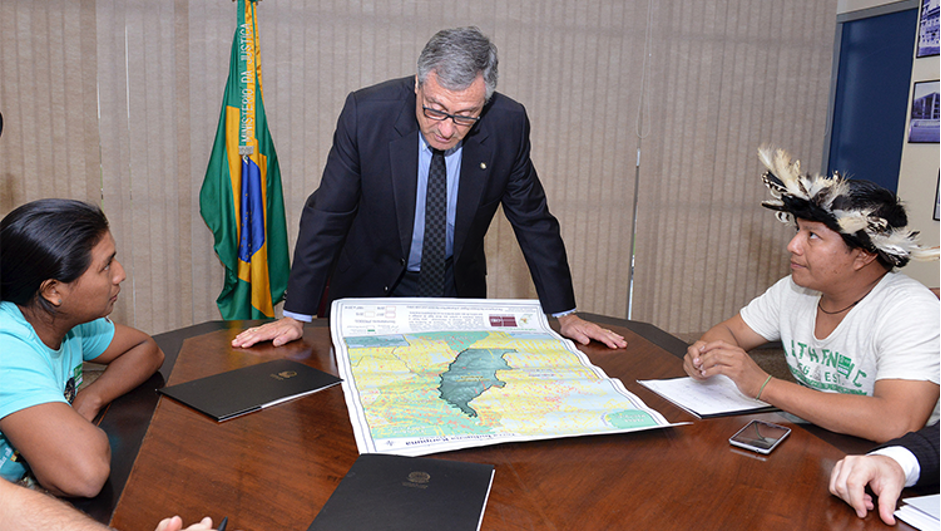
- Investigations and Operations: The complaints repeatedly lodged by the Karipuna people, including in international instances, and formally filed by Greenpeace and CIMI at the MPF-RO and also to other authorities, resulted in the decision by the Federal Court for the urgent protection of the Karipuna people, in 2018. From this event on, the MPF, the Federal Police (PF) and the Brazilian Army have joined forces in a series of operations to investigate and protect the Indigenous Land and the Karipuna People from invasions and threats. In April 2019, this articulation was cemented by the MPF as the Amazon Task Force. Some of these investigations and operations are as follows:
- Carried out in September 2018, Operation Kuraritinga, the first of a series of federal actions developed, was led by the MPF and the PF, with support from FUNAI and the Environmental Military Police. The Operation revealed that rural properties located on the border of the Karipuna territory were used to store machinery for illegal logging. The focus of this operation, according to the Federal Police, was to identify who is effectively financing these invasions, stimulated by the promise that the land plots would be regularized inside the Karipuna Indigenous Territory. Also, according to the investigation, it became evident that farmers not involved in the criminal activities are threatened by the loggers to collaborate with them. Also, in the ambit of the Operation, in January 2019, a deployment of 50 federal police officers and Army soldiers served search and seizure warrants on the border of the Karipuna territory, with the confiscation of a tractor and a loader used to remove wood from inside the indigenous land. At the time, there was also a meeting with representatives of the Operation, MPF-RO, FUNAI, the Ministry of Women, Family and Human Rights, the governor of Rondonia, Colonel Marcos Rocha, and representatives of the Karipuna people. On the occasion, the authorities undertook to join forces in order to promote dialogue and continuous and integrated actions against the invasions in the Karipuna land.
- In June 2019, Operation SOS Karipuna mobilized more than 500 military, police and public servants in order to dismantle criminal organizations installed in the Karipuna territory. One of the focus points of the Operation was to detect those responsible for illegal actions of land grabbing (illegal land appropriation), land allotment and commercialization of areas inside the Karipuna Indigenous Territory. According to the Federal Police and the MPF, land grabbers and invaders, assisted by the Association of Rural Producers of Boa Esperança (ASPRUBE) and the georeferencing company “Amazon Gel”, deceived potential buyers of land plots within the Karipuna territory, with the false guarantee of land title regularization, saying that the land “was no longer indigenous land”. The Operation also revealed the practice of “wood laundering”, which consists of an illegal scheme to obtain virtual credits for selling wood extracted from the Karipuna Indigenous Territory through the Forest Origin Document Issuance System (SISDOF). In other words, by entering fake data into the IBAMA’s system, an aspect of lawfulness is given to the commercialization of wood illegally taken from the Karipuna Indigenous Territory. As a result of the action, more than 50 warrants of temporary arrest, preventive arrest and search and seizure were issued, plus more than 20 measures such as disclosures of bank account information, suspension of activities and sealing of establishments, as well as the seizure of more than R$ 46 million of assets of the investigated.
- In April 2020, at the peak of the new coronavirus pandemic, Karipuna Indigenous spotted four invaders clearing an area of forest less than ten kilometers from Panorama Village, where they live and were in isolation seeking protection from the pandemic, a fact that illustrates how the actions of invaders have not dropped during the quarantine. In this scenario, in October 2020, the Federal Police carried out actions to arrest nine people suspected of causing fires and deforestation in the Karipuna land, identified since implementation of Operation SOS Karipuna. The action was part of the Operation Kawyra, promoted jointly with FUNAI and the Brazilian Army.
- According to the MPF, through these investigations and operations, it was possible to identify the modus operandi of the criminal organizations that operate in other invasions in the State of Rondonia. The process of attempted land grabbing starts with logging, the opening of roads to enable raw material removal, followed by deforestation, which may include a burning process to “clean” the area. In general, these organizations act with the creation of an association that seeks for the regularization of vast territories inside indigenous lands or conservation units. They employ a georeferencing “expert” to divide the lots, with demarcation and definition of the boundaries and appeal to alleged legal instruments (alluding to land possession regularization programs, among others), which would confer an apparent legality and transmit the idea that the land to be acquired would be in the process of being legalized. Finally, such actions would co-opt interested parties, mainly in the region itself, who would pay for the simple fact of becoming members of the association, for the purchase of the plots or regularization services, and also for the geo-referencing and demarcation of the plots.
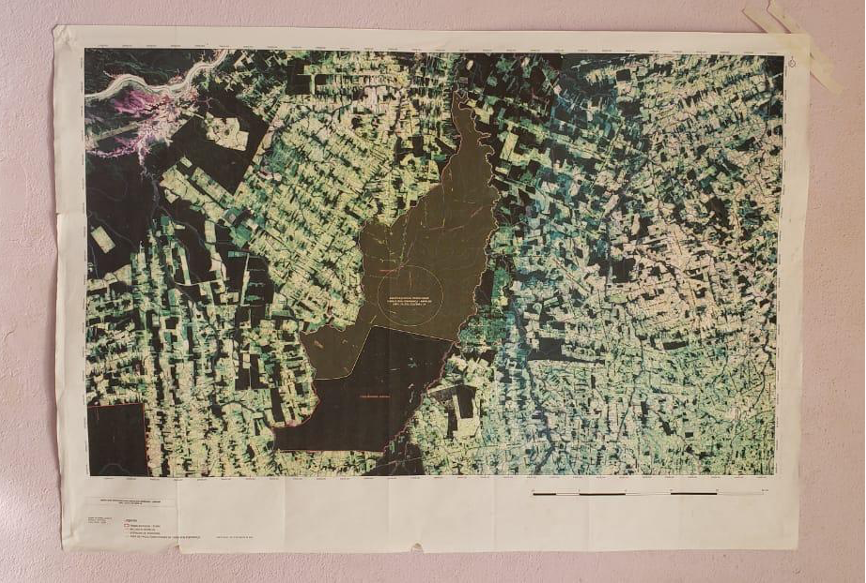
- Media coverage: The partnerships between Apoika, CIMI, and Greenpeace are also very important to ensure visibility of the violations faced by the Karipuna People, through the cooperation with major national and international media outlets. In this sense, in February 2019, Greenpeace promoted a media trip with Time Magazine to the Karipuna territory, where journalists were able to access the Karipuna struggle from the narrative of their own leaders and document, in loco, the degradations inflicted to the territory by illegal invaders. – The trip resulted in a story that was part of Time Magazine’s special edition on climate change and deforestation in the Amazon rainforest. Also in partnership with Greenpeace, in 2019, the German channel TV ARD made a media trip to cover the 1st Karipuna Land Encounter. Through the partners, there was also articulation with BBC and Al Jazeera, among other vehicles, which resulted in reports that support the dissemination of the Karipuna’s demands and the awareness of the national and international audience
- Ancestrality, union and female leadership: The challenges faced in the Karipuna Indigenous Land are also common to other indigenous and traditional territories in the Amazon Basin region. However, it is added by the fact that the Karipuna have a population of only 60 people. Thus, the success of the strategies undertaken depended essentially on the community’s union and organization so that, together, they could structure actions for territorial monitoring, evidence collection, coordination with partner organizations, complaint to the authorities, and promotion of awareness campaigns. In the case of the Karipuna, this union is symbolized in the figure of Katiká Karipuna, matriarch of the community who has reflected in her history the years of resistance and who portrays the bravery and unity of the Karipuna People who, after coming close to extinction following contact in the 1970’s, have risen up in the fight to defend their territory against organized crime.
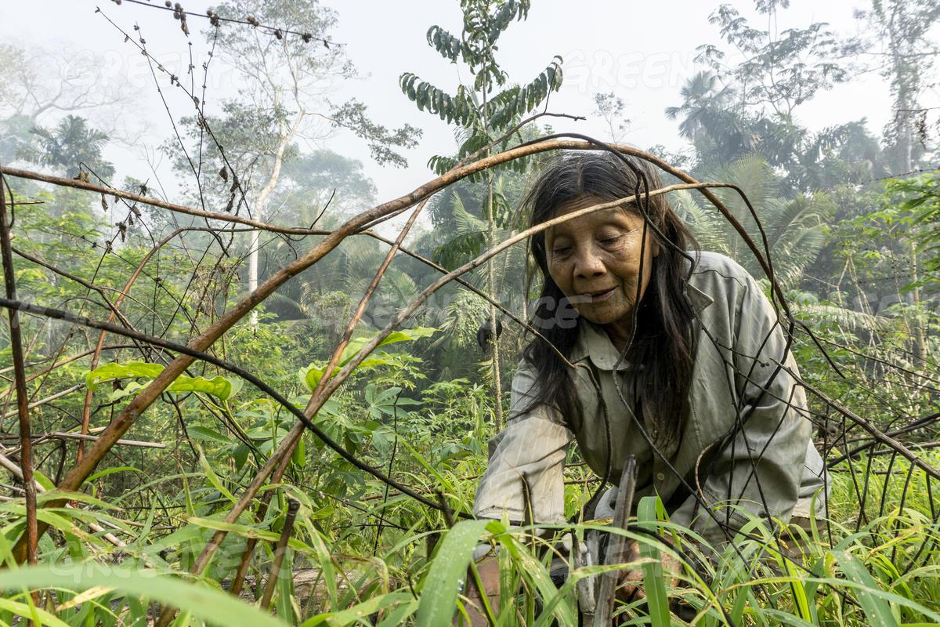
3.3. Benefits: added value and case impacts
- Strategic partnerships: It is known that for territorial protection actions to be more effective, the support of partners is crucial, especially for the expansion of strategies and broader reach of the actions of complaint and advocacy. However, this becomes even more evident in cases like that of the Karipuna People that, due to a very small population (60 people), have even more limitations to promote territorial defense actions without counting on the strategic support of allies. In this regard, by promoting collaborative actions, there is an exchange of learning and mutual maturation between the indigenous movement and civil society organizations, which can facilitate the development of similar strategies in other cases of territorial and rights protection.
- Data collection: The collection of data carried out during territorial monitoring actions, through collaboration with strategic partners, is a key factor in the success of the legal actions promoted for the protection of the Karipuna’s rights to date. The data and evidence are crucial to verify the dimension, location, and perpetrators of the illegal activities that take place in the territory, besides providing a factual basis for complaints to the competent authorities. Furthermore, as proven by satellite data monitoring carried out jointly with Greenpeace, it is essential that indigenous communities and civil society promote, whenever possible, independent territorial monitoring, in order to enable a better understanding of the dynamics of environmental degradation of the territory, and thus better guide the practical action of political advocacy in defense of territory protection. Finally, monitoring actions by using technologies are especially beneficial to indigenous communities such as the Karipuna, which, due to their small population, have greater limitations in promoting field monitoring, for safety reasons in eventual confrontations with invaders.
- Law enforcement and replicability: One of the greatest legacies of the Karipuna case is the recognition by the Federal Prosecution Service of Rondonia and the Federal Police that it is imperative that fighting the organized crime that operates inside and around the Amazon indigenous lands be the first priority of the Brazilian State. Even if this factor represents the fulfillment of the institutional role of such bodies, regrettably, such action is not observed in many cases in the Amazon Basin region, where the State’s inertia aggravates the violation of rights in the territories. Furthermore, the investigations, operations, and legal actions undertaken in recent years in the Karipuna territory have great potential for scalability and replicability to other initiatives against criminal activities carried out in other indigenous lands in Rondonia and the Brazilian Amazon. According to the MPF, there is the prospect of replicating the operation model of the SOS Karipuna Action in the defense of other protected areas in the State of Rondonia, such as the Uru Eu Wau Wau indigenous land, which constantly undergoes illicit exploitation and land grabbing by criminal organizations.
4. Chronology
See more information about:
Videos
- First contact of the Brazilian Indigenous Foundation (FUNAI) one of the Karipuna communities of Rondonia in 1976. Part I [Primeiro contato da Fundação Nacional do Índio (FUNAI) com uma das comunidades dos Karipuna de Rondonia no ano de 1976. Parte I]
- First contact of the Brazilian Indigenous Foundation (FUNAI) one of the Karipuna communities of Rondonia in 1976. Part II [Primeiro contato da Fundação Nacional do Índio (FUNAI) com uma das comunidades dos Karipuna de Rondonia no ano de 1976. Parte II]
- CIMI and Greenpeace: Karipuna people resist and face pressure from loggers, ranchers and land grabbers in the Amazon (2020) [Povo Karipuna resiste e enfrenta pressão de madeireiras, pecuaristas e grileiros na Amazônia]
- Greenpeace: Karipuna people resist the destruction of their forests (2019) [Povo Karipuna resiste à destruição de suas florestas]
- Greenpeace: Guardians of the Forest: 1st Encounter in the Karipuna Indigenous Land (2019) [Guardiões da Floresta: I Encontro na Terra Indígena Karipuna]
- Greenpeace: 1st Encounter in the Karipuna Indigenous Land (2019) [I Encontro da Terra Indígena Karipuna]
- G1: Karipuna Indigenous report invasions and land grabbing inside their territory (2019) [Índios Karipuna relatam invasões e grilagem dentro de território]
- BBC: Devastating deforestation (2019)
- Time Magazine: The Tipping Point (2019)
- Al Jazeera: ‘Surrounded, afraid’: The indigenous guardians of Brazil’s Amazon (2019)
- Greenpeace: Karipuna’s land and livelihood under threat (2018)
- FUNAI: Overflying the Uru Eu Wau Wau and Karipuna Indigenous Lands (2018) [Sobrevoo TIs Uru Eu Wau Wau e Karipuna]
- Greenpeace: Speech by Adriano Karipuna at the 17th Session of the United Nations Permanent Forum on Indigenous Issues (2018) [Fala de Adriano Karipuna durante a 17ª Sessão do Fórum Permanente sobre Assuntos Indígenas das Nações Unidas (ONU)]
- CIMI: Speech by CIMI and André Karipuna during the 4th session of the UN Intergovernmental Working Group on Transnational Corporations and other Business Enterprises with respect to Human Rights (OEIGWG) (2018) [Fala de Cimi e André Karipuna durante a 4a sessão do Grupo de Trabalho Intergovernamental sobre Empresas Transnacionais e outras Empresas de Negócios com respeito aos Direitos Humanos (OEIGWG) da ONU]
- Greenpeace: Karipuna Indigenous in Brasília (2018) [Indígenas Karipuna em Brasília]
- Greenpeace:In the Brazilian Amazon, Indigenous people deal with a violent new world (2017)
Files
- How the Karipuna people expelled criminals from their land in the Amazon (Mongabay, 2020) [Como o povo Karipuna expulsou criminosos de suas terras na Amazônia]
- Final Message of the 1st Karipuna Indigenous Land Encounter (2019) [Mensagem Final do I Encontro da Terra Indígena Karipuna]
- Complaint made by Greenpeace and CIMI to the Federal Prosecution Service (MPF) (2018) [Denúncia feita pelo Greenpeace e Cimi ao MPF]
- Speech by Adriano Karipuna to the UN Permanent Forum on Indigenous Issues (2018) [Pronúncia de Adriano Karipuna ao Fórum Permanente da ONU sobre Questões Indígenas]

